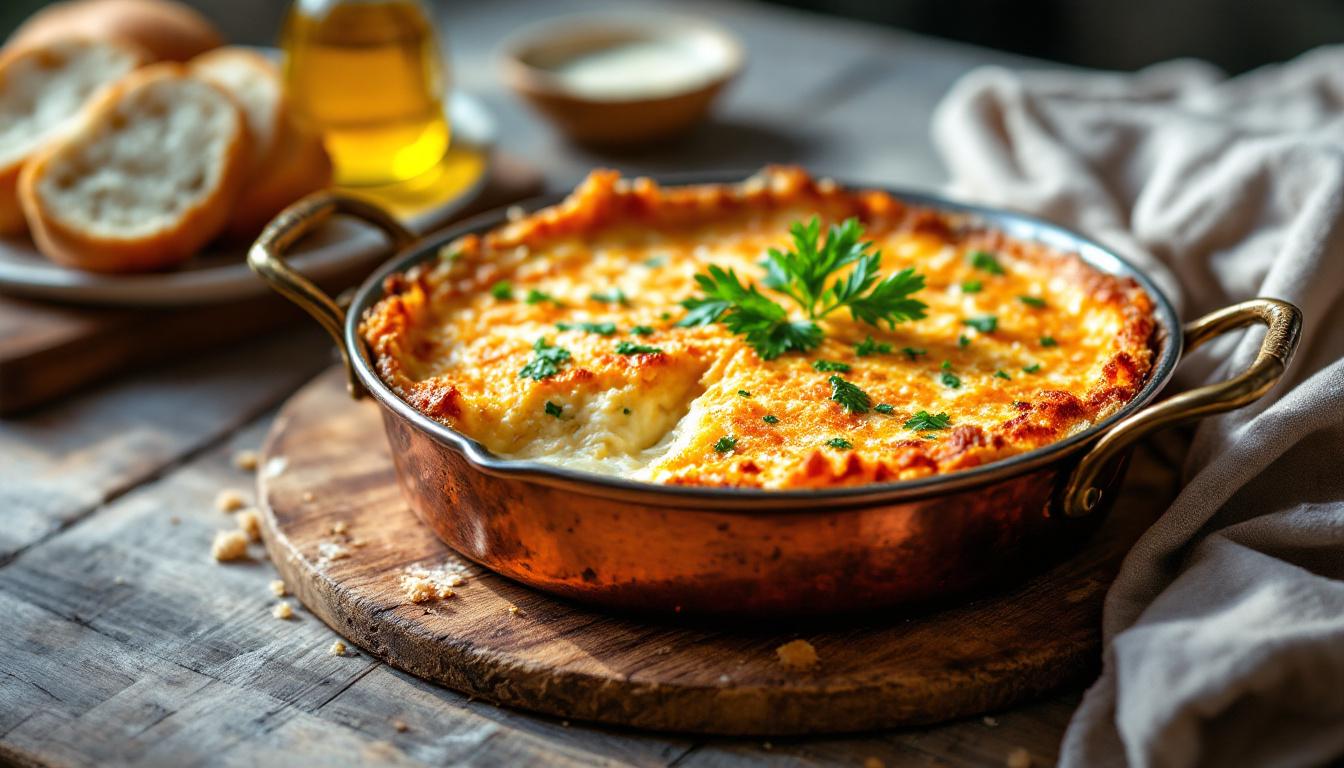I still remember the first time I prepared authentic brandade de morue in my tiny apartment after returning from Provence. The gentle aroma of garlic-infused milk, the rhythmic whisking as olive oil transformed simple ingredients into silken luxury—it was like capturing Mediterranean sunshine in a dish. What began as humble salt cod and potatoes became something magical through one crucial technique: creating a perfect emulsion. This centuries-old Provençal specialty might require patience for the salt cod preparation, but the reward is a dish that somehow tastes both rustic and refined in the same delicious bite.
The Story 📖
Brandade de morue gratinée represents the ingenuity of Mediterranean coastal cuisine, where preserved ingredients transform into celebration food. During my years cooking in southern France, I learned that this dish originated as practical sustenance for fishermen but evolved into a Christmas Eve tradition throughout Provence. The magic lies in the contrast between the crisp golden crust and the cloud-like, garlicky interior. What fascinates me most is how something requiring such minimal ingredients creates such profound depth of flavor—proof that sometimes the simplest dishes require the most technique.
Ingredients Spotlight 🧪
For the brandade:
- 500g (1.1 lbs) dry salt cod, boneless and skinless
- 500g (1.1 lbs) Yukon Gold or Russet potatoes
- 4 large garlic cloves, peeled but whole
- 300ml (1¼ cups) whole milk
- 150ml (⅔ cup) extra-virgin olive oil, plus more for finishing
- Zest of 1 lemon
- White pepper to taste
- Pinch of cayenne (optional)
For the gratin topping:
- 50g (½ cup) fine breadcrumbs
- 1 tablespoon chopped fresh parsley
- 1 tablespoon extra-virgin olive oil
Step-by-Step Guide 📝
- Desalt the cod: Soak the salt cod in cold water for 48-72 hours in the refrigerator, changing the water 3-4 times daily. When properly desalted, it should taste mildly salty but not bitter.
- Prepare the cod: Place desalted cod with garlic cloves in a saucepan, cover with milk, and bring to a gentle simmer (do not boil). Cook for 10-12 minutes until the cod flakes easily. Remove cod and garlic, reserving the milk.
- Cook the potatoes: Meanwhile, peel and cube potatoes. Boil in salted water until tender (15-20 minutes). Drain thoroughly and immediately rice while still hot.
- Create the emulsion: In a warm bowl, combine flaked cod, softened garlic, and hot riced potatoes. Begin whisking vigorously while drizzling olive oil drop by drop initially, then in a thin stream once emulsion forms. Add lemon zest, white pepper, and cayenne if using.
- Adjust consistency: Gradually incorporate some of the warm reserved milk, whisking continuously until you achieve a silky, fluffy texture that holds its shape but isn’t stiff.
- Prepare for baking: Preheat oven to 190°C (375°F). Transfer brandade to a gratin dish or individual ramekins. Mix breadcrumbs with parsley and olive oil, then sprinkle evenly over top.
- Bake: Place in oven for 20-25 minutes until the top is golden brown and the edges begin to bubble. For extra crispness, finish under the broiler for 1-2 minutes, watching carefully.
- Serve: Let rest 5 minutes, drizzle with your best extra-virgin olive oil, and serve immediately with crusty bread and a simple green salad.
Expert Techniques 🛠️
The secret to transcendent brandade lies in three critical techniques. First, proper desalting—test by boiling a small piece after soaking; it should taste pleasantly of the sea, not overwhelmingly salty. Second, rice the potatoes while piping hot—cold potatoes will make your brandade gummy. Finally, the emulsion technique: treat it like making mayonnaise, starting with drops of oil before increasing to a thin stream while whisking vigorously.
Chef’s Note: If your brandade looks like it’s separating during the emulsion process, don’t panic! Add a teaspoon of cold water and whisk energetically. This will help the mixture come back together. Think of it like rescuing a broken hollandaise—it’s all about creating a stable emulsion between the oil and the starchy base.
The texture you’re aiming for should be light enough to hold the impression of a spoon but substantial enough to support a fork standing upright. Never use a food processor—the friction creates gumminess. Instead, embrace the meditative quality of hand-whisking; your arm might tire, but the result will be ethereal.
Presentation & Pairing Ideas 🍽️
For an elegant presentation, serve individual portions in shallow cazuelas or small cast-iron cocottes. The traditional Provençal accompaniment is a simple arugula salad dressed with lemon and olive oil—the peppery greens and bright acidity balance the rich brandade beautifully. For wine, choose a crisp rosé from Provence or a mineral-driven white like Pouilly-Fuissé that can cut through the richness while complementing the delicate cod flavor.
For a more contemporary twist, serve small portions as an appetizer with lavender-infused crostini. Vegetarians can adapt the technique to create a similar texture using cannellini beans in place of cod—the emulsion method works beautifully with beans for a different but equally satisfying dish.
Brandade makes an unexpected but delightful starter before crème brûlée or vanilla speculoos cream pots for a French-inspired dinner party. The contrast between savory and sweet courses showcases the versatility of French cuisine.
Don’t be afraid to make the recipe your own. The fundamental technique—creating a luxurious emulsion—can be adapted countless ways. Try adding herbs like thyme or tarragon, or experiment with finishing the dish with smoked paprika instead of the traditional breadcrumb crust. After mastering brandade, you’ll find the same principles apply to other emulsified dishes like brown butter sauces or spiced aioli. That’s the beauty of classic techniques—once they’re in your repertoire, the possibilities are endless.
